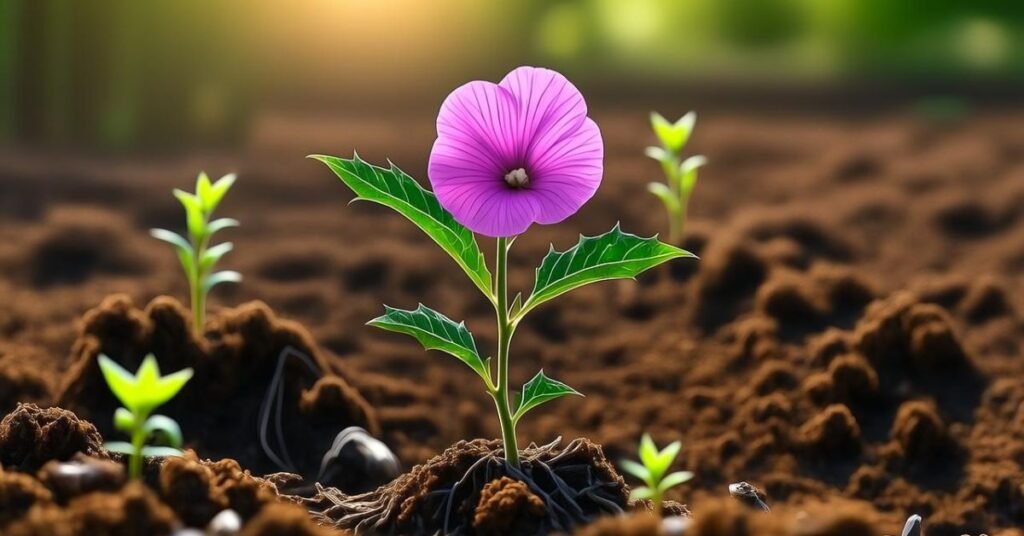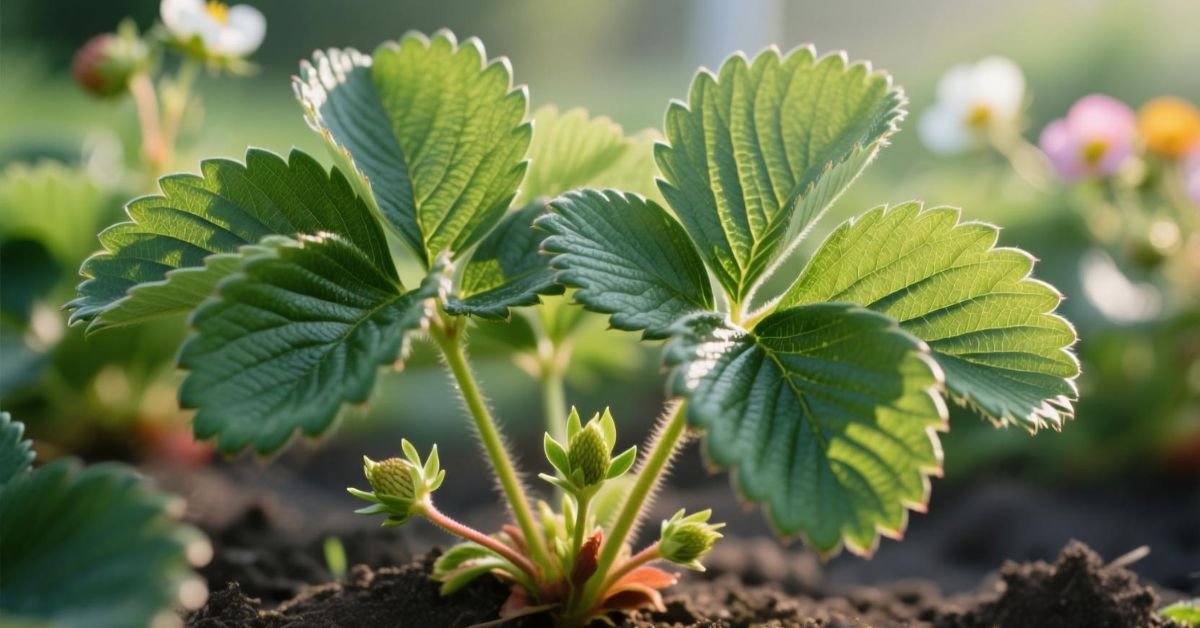Introduction
Strawberry leaves are more than just greenery. They are the plant’s way of communicating. Each leaf shows signs of the plant’s health. The shape, color, and texture tell a silent story. Healthy leaves are usually green, vibrant, and firm.
Imagine your garden as a book and each leaf as a page. The changes in strawberry plant leaves can be clues. Curling might mean stress. Yellow spots could point to a disease. Dark edges may warn about nutrient issues. Reading these signs early saves your harvest.
The leaves of strawberry plants are also crucial to the growth and quality of the fruit. They help in photosynthesis, storing energy for the plant. Proper care keeps leaves strong. Strong leaves mean sweeter, juicier strawberries.
Science Behind Strawberry Plant
Strawberry plant leaves work like tiny factories. Through photosynthesis, they convert sunlight into food. This process fuels the plant’s growth and fruit production. The leaf surface has pores called stomata. These help the plant breathe and control water loss.
Inside each leaf, veins carry water and nutrients.Food is made possible by chlorophyll, which gives the leaves their green color. Even slight damage to leaves can affect the whole plant. That’s why healthy leaves mean a healthy strawberry harvest.
Nutritional Value
Strawberry plant leaves offer many health benefits. They are full of essential nutrients. The leaves can be used fresh or dried for teas. They support wellness naturally.

Key nutrients in strawberry leaves:
- Vitamin C : boosts immunity and skin heat
- Calcium : helps maintain healthy teeth and bones
- Iron : improves blood health and prevents fatigue
- Magnesium : supports muscle and nerve function
- Antioxidants : protect cells from damage and aging
Geography/History
Strawberry plants are native to temperate regions. They have been found growing in Europe, Asia, and the Americas. Wild varieties existed long before cultivation. People enjoyed strawberries for their flavor and medicinal uses.
The history of strawberry cultivation dates back centuries. Ancient Romans valued them for taste and healing. Modern garden strawberries were developed in France in the 18th century. Today, they grow worldwide in farms and home gardens.
Role of Strawberry Leaves in Plant Growth
Strawberry plant leaves are essential for growth. They capture sunlight and make food through photosynthesis. This energy supports roots, flowers, and fruit.Through their tiny pores, leaves help regulate water as well. Healthy leaves mean strong plants and better harvests.
Join Gardening & Landscaping
Join gardening and landscaping to enjoy nature’s beauty. Grow plants that bring life to your surroundings. Learn how to design and care for green spaces. Create a garden that reflects your style.Get in touch with others who share your passion for plants.
Seasons/Availability
Strawberry plant leaves are available in most seasons.Spring and summer are the seasons when they grow fresh and vibrant.During fall, they may change color. In winter, leaves can fade or die back, depending on climate.
Gardeners can harvest leaves during the active growing period. Fresh leaves are best for tea or natural remedies. Availability may vary by region and temperature.
| Season | Leaf Condition | Availability |
| Spring | Fresh, green, and soft | High |
| Summer | Full, mature, and healthy | High |
| Fall | Yellowing or curling starts | Moderate |
| Winter | Dormant or faded in cold areas | Low to Moderate |
Watering Affects Strawberry Plant Leaves
Watering has a direct effect on strawberry plant leaves. Leaves become dry and brittle when there is not enough water. Too much water causes yellowing and root problems. Balanced watering keeps leaves green and healthy.

Moist soil supports strong leaf growth. Morning watering reduces evaporation and leaf diseases. Consistent care ensures the plant can produce healthy foliage and sweet fruit.
Applications
Strawberry plant leaves have many uses. They can be used fresh or dried. People use them for health, beauty, and gardening.
Common applications include:
- Herbal tea : supports digestion and boosts immunity
- Natural remedies : helps with inflammation and sore throat
- Compost material : enriches soil for other plants
- Skincare : used in homemade masks for fresh skin
- Animal feed : provides nutrition for certain livestock
Natural Remedies for Damaged Strawberry Plant Leaves
Damaged strawberry plant leaves can be healed with simple methods. Remove any dead or infected leaves. Use neem oil to control pests naturally. Apply compost or organic fertilizer for better growth. Water the plant regularly but avoid overwatering. Healthy care brings leaves back to life.
Causes of Yellowing in Strawberry Plant Leaves
Yellowing leaves are a sign of stress in strawberry plants. It can happen for many reasons. The plant’s health depends on soil, water, and sunlight. Identifying the cause early can save the plant.
Common causes include:
- Nutrient deficiency : lack of nitrogen or iron
- Overwatering : causes root rot and poor oxygen flow
- Underwatering : leads to dehydration and leaf color change
- Pest attack : insects like spider mites damage leaves
- Fungal diseases : such as leaf spot or powdery mildew
- Poor soil drainage : Harms roots by trapping water
Common Problems in Strawberry Plant Leaves
Strawberry plant leaves can face many problemsThere are many signs of stress, such as yellowing, spots, curling, wilting, and holes in the foliage. These issues are often caused by pests, diseases, or poor care.Fruit quality can be affected if they are left untreated.
Each problem has a solution. Good watering habits, proper nutrients, and pest control keep leaves healthy. Removing damaged leaves and improving air circulation helps prevent disease. Natural remedies can protect the plant without harmful chemicals.
| Problem | Cause | Solution |
| Yellowing leaves | Nutrient deficiency, overwatering | Add compost or nitrogen rich fertilizer, reduce overwatering |
| Brown spots | Fungal infection | Remove infected leaves, use neem oil, improve air circulation |
| Curling leaves | Pest damage | Apply insecticidal soap, inspect plants regularly |
| Wilting | Root rot, poor drainage | Improve drainage, water in the morning, avoid soggy soil |
| Holes in leaves | Insect attack | Handpick pests, use garlic or chili spray as repellent |
Seasonal Care for Strawberry Plant Leaves
Strawberry plant leaves need care in every season. Each season has different requirements. Proper attention keeps leaves green and healthy.
Seasonal care tips:
- Spring : Remove old leaves and add compost.
- Summer : Water regularly and protect from pests.
- Fall :Trim damaged leaves and clean the plant bed.
- Winter : Mulch around the base to protect roots.
Conclusion
Strawberry plant leaves are vital for plant health and fruit quality. They show clear signs when the plant is stressed or healthy. Observing them closely helps prevent bigger problems.
With proper care, leaves stay green and strong. Healthy leaves mean sweeter strawberries. A little attention can lead to a beautiful and productive plant.
FAQs
1.Why are the leaves of my strawberry plant turning yellow?
Yellow leaves often mean nutrient deficiency, overwatering, or disease.
2. Are strawberry plant leaves suitable for tea making?
Yes, fresh or dried leaves can be used to make herbal tea.
3. How often should I water strawberry plants?
Water when the soil feels dry, usually 2–3 times a week in warm weather.
4. What pests attack strawberry plant leaves?
Common pests include spider mites, aphids, and slugs.
5. Do strawberry plant leaves die in winter?
In cold climates, leaves may fade or die back but regrow in spring.


